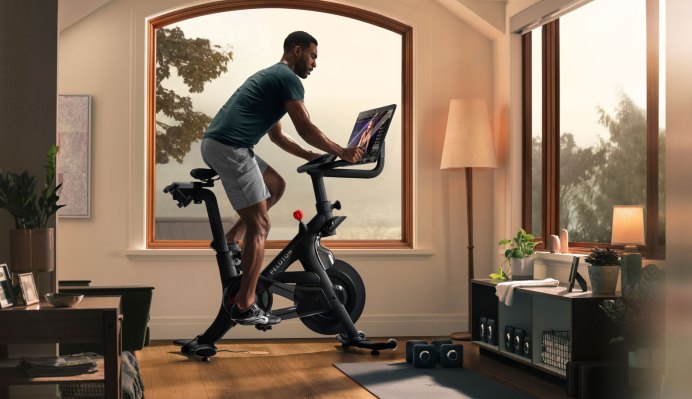“Unprecedented” only begins to scratch the surface of this past year-and-a-half. Entire industries have been made and broken as the global population struggled to adapt to the largest pandemic in a century. Connected fitness falls firmly in the category that made it.
It’s fair to say that 2020 and 2021 have been transformative for home fitness. Years spent building products that let anyone work out at home paid massive dividends as people struggled to find alternative ways to exercise amid gym closures and a dramatic uptick in sedentary lifestyles.
No one roots for a pandemic, of course, but for companies like Peloton, the timing couldn’t have been better. Many who were on the fence about purchasing a pricey treadmill or stationary bike were pushed over the edge as their in-person options shrunk. In February, the company said its subscriber count rose to 1.67 million, up 134% from a year earlier.
But the past few years haven’t been all smooth sailing for the company. From increased competition and early supply chain struggles to a treadmill recall that shook up the industry, there have been several recent roadblocks on the company’s climb.
Peloton CEO John Foley had initially pushed back on the U.S. Consumer Product Safety Commission (CPSC) reports, but ultimately agreed to recall its Tread+ in May, following reports of 70 injuries, including the death of a six-year-old.
At TechCrunch Disrupt 2021 this week, Foley — joined by Peloton chief content officer Jennifer Cotter — discussed broader safety issues with the category, noting that the unfortunate circumstances behind the recall have forced the company to take a closer look at product safety.
“From my perspective, as one of the founders, the framing of the category wasn’t good enough. What the category thought of as safety wasn’t good enough,” says Foley. “We thought, let’s bring treads to market, and from a hardware perspective, they’re the best designed treads. Looking at the safety that’s been in the category for decades, what we learned is, we need to be better. We’re better in almost everything, and now we need to be better in safety.”
The Tread returned to market on August 30, featuring a slew of new safety features, including a key and access code. The Tread+, a rebranded version of the original Tread, is still not available for sale.
Peloton also faced difficulties meeting the sudden surge in demand due to supply chain issues earlier this year.
Addressing those issues and what the company is doing to tackle them, Foley said, “We’re taking a belt-and-suspenders approach to both investing and embracing our contract manufacturers and bringing some manufacturing in-house. You might have heard about our $400 million commitment and manufacturing plant we’re building in Ohio. In the coming years, that will be able to make millions of bikes and treaders per year. We’re also totally committed to our contract manufacturers, largely in Taiwan right now.”
On the competition front, Peloton is undoubtedly still the top connected fitness name, but startups like Mirror and Tonal are actively vying for space in the category, while big names like Apple and Samsung have thrown their hats in the ring, too — Apple made its Fitness+ platform, launched late last year, a centerpiece of its fall hardware event.
“One of the differentiators I feel it will be hard for people to catch up to is our content,” says Cotter. “Not only how frequently we can produce content, but also the production quality. And what people have discovered in the pandemic that’s unique about us is the experience itself. Whether you love to work out or not, you will have fun in a Peloton class.”
But it remains to be seen if the gains the company saw because of the COVID-19 lockdowns will regress as cities reopen.
Foley says the company has not seen a dip so far. “We’re seeing a lot more people get excited about Peloton and say, ‘I’m not going back to the gym, the gym was a failed model. It was a failed contract between the member and the business, and actually, I didn’t go to the gym. It wasn’t convenient, I didn’t want to go drive somewhere and shower outside my home and take that extra time away from my family.’”
The company has been looking to further distinguish itself through a number of acquisitions — over the past year, it bought Atlas Wearables, yoga hardware startup Otari and voice assistant company Aiqudo. How these pieces fit together isn’t entirely clear, but they all appear to point to the company’s play beyond the bike and treadmill into a more ubiquitous lifestyle brand — something Lululemon is trying to accomplish with its acquisition of Mirror.
In addition to a rumored rowing machine, Peloton has also been looking to expand content beyond video to see “how far we can go as a media company,” Cotter said in a recent interview.
Gamification is a clear piece of the puzzle and taps into Peloton’s community focus and embraces users’ competitive streak. “We have every type of person who buys a Peloton and downloads the app,” says Cotter. “So we want to meet them where they are [ … ] There’s badges — you can’t believe how much members want the badges. There’s a gamified experience throughout Peloton that helps people connect and keep connected.”
It’s been a turbulent year for connected fitness, especially for Peloton. There have been no shortage of successes and lessons learned the hard way, but the company is convinced it will emerge the other side stronger from all of it.

